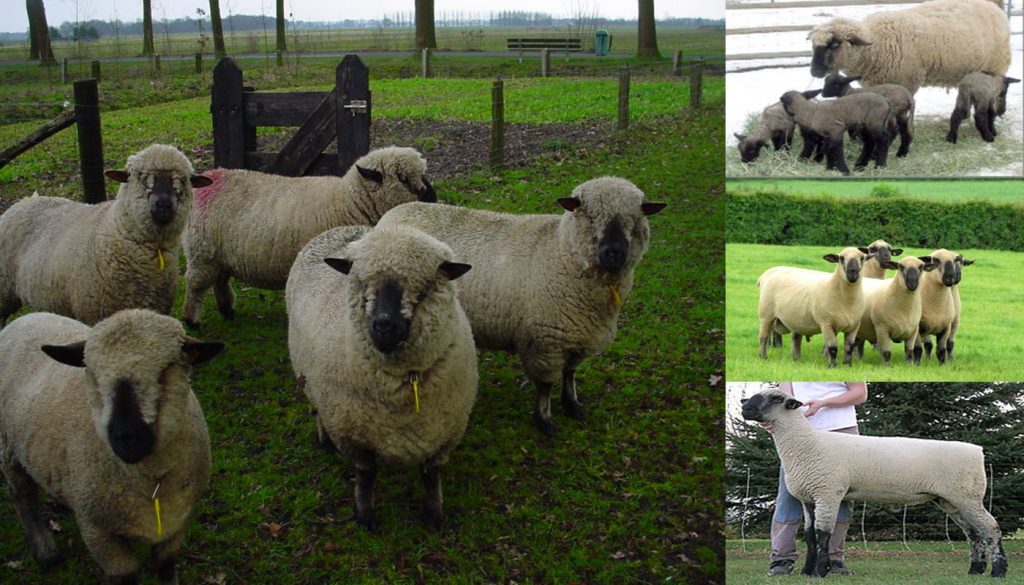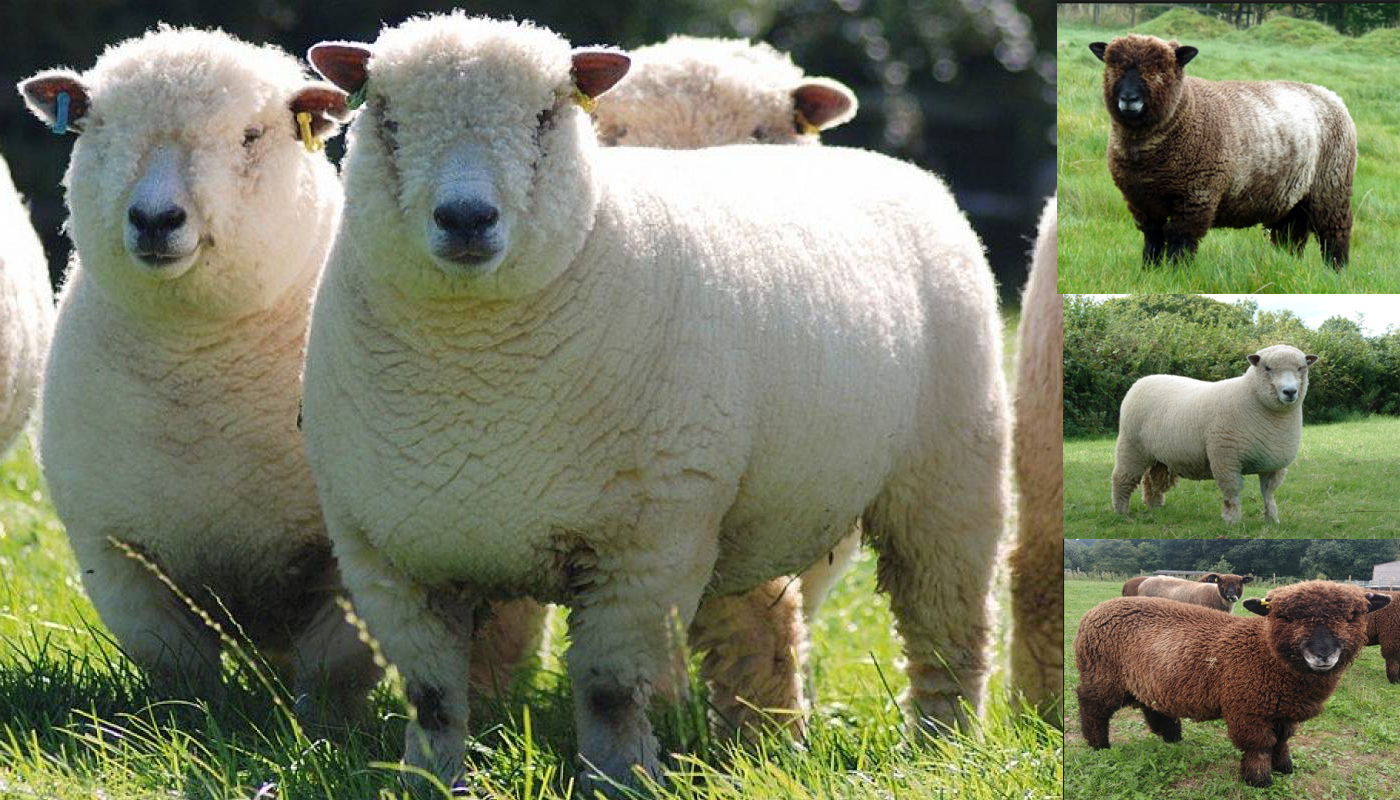
The Hampshire sheep were primarily bred to keep the thin soil of various downlands in Britain fertile.
They are a medium to large sized breed that are excellent producers of meat, wool and good with landscape management. They are one of the top choices for junior/youth sheep exhibition competitions such as the 4-H and FFA.
HAMPSHIRE SHEEP QUICK PROFILE OVERVIEW |
|
|---|---|
| They are pretty sturdy and trim looking sheep with interesting facial features created by the rivers of wool on their faces. | |
| Country of Origin: | United Kingdom |
| Other Names: | Hampshire Down |
| Breed Size: | Medium to Large |
| Main Purpose: | Meat, wool and landscape management |
| Can be used for | Breed, Meat, Skin, Wool **LSC (Landscape Management) |
| Temperament: | Alert, laid back, quiet and calm |
| Ideal Climate: | Most climates |
| Conservation Status: |
Not Listed by the *ALC Status/ Rarity: Common |
| Health Issues? | No known health issues |
| Good Starter Sheep? | Novice to intermediate sheep farmers/keepers |
| Sheep Associations: | American Hampshire Sheep Association and the Hampshire Down Sheep Breeders’ Association |
| Sheep Clubs: | American Hampshire Sheep Association and the Hampshire Down Sheep Breeders’ Association |
| Note: *ALC stands for American Livestock Conservancy ** LSC stands for Landscape Management – the animal is used for controlling various vegetation growth |
|
PHYSICAL CHARACTERISTICS |
||||||||||||||||||||||||||||||||
|---|---|---|---|---|---|---|---|---|---|---|---|---|---|---|---|---|---|---|---|---|---|---|---|---|---|---|---|---|---|---|---|---|
| They are an active lively sheep breed with a longish body, medium length legs with are black. Their faces are partly covered by wool and usually a dark brown or black in color. | ||||||||||||||||||||||||||||||||
| Color(s): | White | |||||||||||||||||||||||||||||||
|
||||||||||||||||||||||||||||||||
EWE BREEDING & MILKING INFORMATION |
|
|---|---|
| They have an extended breeding period with high lambing percentage with hardly any birthing difficulties. They produce vigorous, fast growing and active lambs. They usually have a high percentage of multiple birthds | |
| Breeding Period/cycle: | Usually lasts 16 to 59 hours |
| Estrous cycle: | Ave. 17 days/15 to 20 days |
| Gestation Period: | Usually, around 149 to 155 days but most gestation is 152 days |
| No. Lambs/Litter: | 1 to 2 (twins) lambs in a season |
| Lactation Period: | Usually, around 150 to 240 day but most are milked for 180 days |
| Milking From: | 4 to 6 weeks after lambing |
| Milk Quality: | Good, Quantity: Ave. 180 to 495 liters, Per: Lactation period |
| Milk Ideal for: | Lambs |
| You may Also Like: | 10 Best Sheep Breeds for Milk |
SHEEP MEAT PRODUCTION INFORMATION |
||||||||||
|---|---|---|---|---|---|---|---|---|---|---|
| They have an excellent grade quality with fast growing lambs that reach their targeted dead weights at around 12 weeks. They have longer, more muscled and leaner carcasses. Lean, succulent, tender meat with a fine flavor and grain. | ||||||||||
| Meat Production: | Yes, Quality: Excellent | |||||||||
|
||||||||||
| You may Also Like: | 11 Best Sheep Breeds for Meat Production | |||||||||
SHEEP WOOL PRODUCTION INFORMATION |
||||||||||||||||
|---|---|---|---|---|---|---|---|---|---|---|---|---|---|---|---|---|
| Most sheep produce some form or wool. Some breeds are hair sheep and they are not used for their wool whilst other wool sheep have a low quality of wool that would be used for some form of production such as maybe Lanolin, etc. | ||||||||||||||||
| Wool Production? | Yes, Quality: Medium with a spinning count of 46s to 58s | |||||||||||||||
| Wool is used to Produce: | Ideal and in demand for hand spinners. They are used for other garments, wools, etc. | |||||||||||||||
|
||||||||||||||||
| You may Also Like: | 18 Best Wool Producing Sheep Breeds | |||||||||||||||
SHEEPSKIN PRODUCTION INFORMATION |
|||||||
|---|---|---|---|---|---|---|---|
| In years gone by their skin was used in leather production and was quite a fine quality leather used for skins, cloves and shoes. Their leather is still used but not as often as it once was due to the preferred sheep skin breeds. | |||||||
| Skin Production? | Yes, Quality: Fine | ||||||
| Skin is used to Produce: | Kid skin leather products such as shoes, car seats, fine leather coats, gloves, etc. Chamois cloths, leather goods such as seats, shoes and other garments and leather materials such as furniture, etc. |
||||||
|
|||||||
GOOD TO KNOW ABOUT THE HAMPSHIRE SHEEP |
|
|---|---|
| A few more interesting facts to know about the breed | |
| Child-Friendly? | No livestock should be left unattended around children |
| Landscape Management? | They are excellent at landscape managers and were used to help with soil fertilization. |
| Where to buy them? | Please refer to the American Hampshire Sheep Association and the Hampshire Down Sheep Breeders’ Associationfor information on breeders |
GENERAL INFORMATION
The Hampshire sheep breed has an excellent temperaments and is a very popular choice for juniors in 4-H and FFA competitions. Apart from their great temperaments they have a very beautiful appearance and carriage position.
HISTORY
The Hampshire sheep breed also known as the Hampshire Down sheep originated from a cross between Southdown, Wiltshire Horn and Berkshire Knot breeds of sheep over 150 years ago.
They became a breed that were vital to maintaining the thin downland soils fertility in Berkshire, Wiltshire and Hampshire.
Over the past few decades through carefully selected breeding for their meat with a fast growth rate, high muscling conformation and killing out percentage. They have been bred to have less back fat for better meat quality.
Hampshire sheep were first imported to America in 1840 although it is thought that not many, if any of the breed actually survived the Civil War. Thus, the first successful import of the Hampshire sheep breed to the United States was in 1879 and the American Hampshire Sheep Association was started in 1889.
VIDEO
USEFUL LINKS
- United States Lamb Resource Center
- American Sheep Industry Association
- American Sheep Industry Association List of Breed Associations & Standards
- American Milk Sheep Association
- Dairy Sheep Association of North America
- American Wool Council
- Fur Commission USA
- North American Meat Institute
- American Lamb Board
- National Lamb Feeders Association
- American Livestock Conservancy
- Animal Shelter (ASPCA)
- American Veterinary Medical Association
- American Animal Welfare Society
- American Animal Control
- American Animal Husbandry Society
- United States Department of Agriculture
 Teeswater Sheep Breed – Everything You Need to Know
Teeswater Sheep Breed – Everything You Need to Know Targhee Sheep Breed – Everything You Need to Know
Targhee Sheep Breed – Everything You Need to Know 11 Best Sheep Breeds for Meat Production
11 Best Sheep Breeds for Meat Production Romney Sheep Breed – Everything You Need to Know
Romney Sheep Breed – Everything You Need to Know Romanov Sheep Breed – Everything You Need to Know
Romanov Sheep Breed – Everything You Need to Know Shetland Sheep Breed – Everything You Need to Know
Shetland Sheep Breed – Everything You Need to Know Ryeland Sheep Breed – Everything You Need to Know
Ryeland Sheep Breed – Everything You Need to Know Coopworth Sheep Breed – Everything You Need to Know
Coopworth Sheep Breed – Everything You Need to Know Welsh Mountain Sheep Breed – Everything You Need to Know
Welsh Mountain Sheep Breed – Everything You Need to Know Norfolk Horn Sheep Breed – Everything You Need to Know
Norfolk Horn Sheep Breed – Everything You Need to Know Navajo-Churro Sheep Breed – Everything You Need to Know
Navajo-Churro Sheep Breed – Everything You Need to Know Dorper Sheep Breed – Everything You Need to Know
Dorper Sheep Breed – Everything You Need to Know